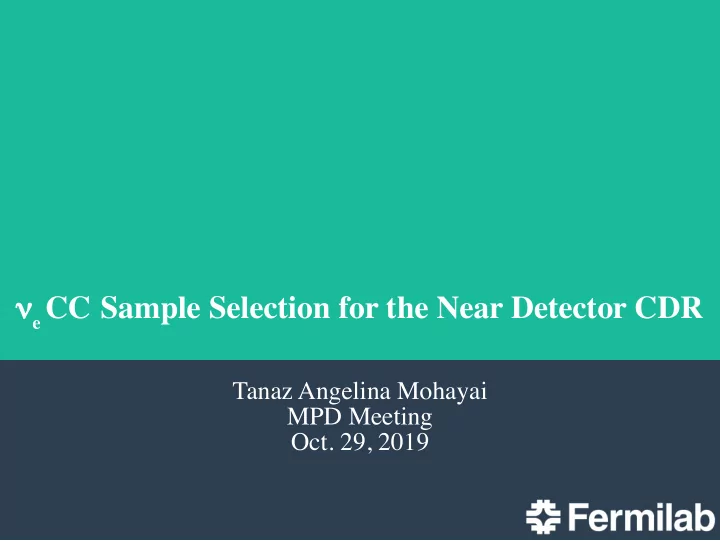

n e CC Sample Selection for the Near Detector CDR Tanaz Angelina Mohayai MPD Meeting Oct. 29, 2019
n e CC Sample Selection Plans Motivation for a n e CC sample selection for the CDR: In LArTPC, n m CC p 0 s can be misidentifjed as n e CC Use HPgTPC to constrain LArTPC’s n m CC p 0 backgrounds : p 0 s rarely convert in HPgTPC p 0 s that do convert, primarily convert via Dalitz decay so the outgoing e+e- pair can be sign tagged To select a pure sample of n e CC in HPgTPC, need to come up with a set of cuts – common backgrounds to n e CC sample in HPgTPC: (already mentioned above) p 0 /g conversion Compton scattered electrons Delta rays from outside of fjducial volume (OOFV) interactions g s from rocks 2 2019-10-29 T. A. Mohayai
Some Thoughts on the Cuts (Based on Past Experience) Fiducial cut: discard photon conversions too close to the HPgTPC boundary – this is to allow photon converted/Dalitz decay electrons to travel enough distance to be able to separate out in B-fjeld Angular cut: cut on the signature angular shape of the electron/positron pairs from g conversion – much wider opening angle compared to the primary electrons Energy cut: discard the mono-energetic g s that lead to Compton electrons (Leo has shown this in the past) Two-track from same vertex cut: discard electron-positron pairs that share the same initial track position Any suggestions? 3 2019-10-29 T. A. Mohayai
n e CC Sample Selection Plans Motivation for a n e CC sample selection for the CDR: In LArTPC, n m CC p 0 s can be misidentifjed as n e CC Use HPgTPC to constrain LArTPC’s n m CC p 0 backgrounds : p 0 s rarely convert in HPgTPC p 0 s that do convert, primarily convert via Dalitz decay so the outgoing e+e- pair can be sign tagged To select a pure sample of n e CC in HPgTPC, need to come up with a set of cuts – common backgrounds to n e CC sample in HPgTPC: (already mentioned above) p 0 /g /g conversion Compton scattered electrons Delta rays from outside of fjducial volume (OOFV) interactions g s from rocks 4 2019-10-29 T. A. Mohayai
Current Status of n e CC Selection (for fjrst look at this) selected true n e CC sample, then true primary electrons (“signal”), and true electrons/positrons from photon conversions (“background”) Shape differences between the “signal” electrons and the “background” electron/positrons can be used as cut – Dalitz decay electrons/positrons have wider and generally larger angles wrt incoming n s than primary electrons 5 2019-10-29 T. A. Mohayai
Current Status of n e CC Selection Cutting on high angles would not discard all of the background electrons/ positrons – so one can look at energy and position (e.g. cut on electrons and positrons that share the same vertex) 6 2019-10-29 T. A. Mohayai
Current Status of n e CC Selection Cutting on high angles would not discard all of the background electrons/ positrons – so one can look at energy and position (e.g. cut on electrons and positrons that share the same vertex) momentum [GeV] 7 2019-10-29 T. A. Mohayai
Summary & Next Steps The plan is to come up with a set of cuts to reject the common backgrounds to n e CC sample in HPgTPC – common backgrounds are: p 0 /g conversion Compton scattered electrons Delta rays from outside of fjducial volume (OOFV) interactions g s from rocks p 0 /g conversion and Compton scattered electrons have already been explored, what remains are the OOFV interactions that can be misidentifjed as n e CC in HPgTPC Next steps: fjnish defjning a set of cuts and following that, quantify the selection effjciency 8 2019-10-29 T. A. Mohayai
Addition Slides 9 2019-10-29 T. A. Mohayai
Note about dE/dx-based PID Need to be careful about cutting out low momentum/energy electrons from the sample (in an attempt to discard the background electrons to nueCC sample) – dE/dx-based PID loses effjciency towards higher momenta From Tom Junk 0.03 0.09 0.35 1 3.5 10 35 10 2019-10-29 T. A. Mohayai
Recommend
More recommend